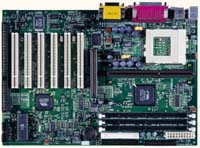Tyan S1854 Trinity 400 VIA Apollo Pro 133A Slot-1/Socket-370 ATX
by Mike Andrawes on January 11, 2000 6:16 PM EST- Posted in
- Motherboards
Tyan has been producing top notch, high performance server/workstation motherboards for over 10 years. Although they've had a few hiccups along the way, they've been able to transition to the higher volume consumer space in recent years. For the most part, their server roots have shown in their consumer level boards, which were rock solid as far as stability goes and very rich in features.
For the most part, Tyan's success was built upon boards based on Intel chipsets. With the advent of the Super7 platform, they were forced to branch out and use VIA chipsets if they wanted to support Super7. Some of Tyan's early VIA based efforts were less than stellar, but the S1598 Trinity MVP3 restored our confidence in such boards.
With the launch of the "Coppermine" Pentium IIIE and its subsequent official support for the 133 MHz bus, an interesting situation arose for VIA and Intel in the chipset market. Intel's solution, the i820 was delayed by a few months do to stability issues. Throw in the fact that RAMBUS currently costs almost five times what SDRAM costs, and VIA's Apollo Pro 133A chipset begins to look very appealing. Tyan decided to go with the Apollo Pro 133A and teamed up with Micron to have one of the first 133 MHz FSB solutions in the market with the latest iteration of the Millennia Max. The motherboard in that award winning system - the Tyan S1854 Trinity 400.
New Anand Tech Report Card Rating 88/B+
| CPU Interface | Slot-1/Socket 370 |
| Chipset | VIA Apollo Pro 133A (VIA 694X / VIA 596B) |
| L2 Cache | N/A (on-chip) |
| Form Factor | ATX |
| Bus Speeds | 66
/ 75 / 83 / 95 100 / 112 / 117 / 124 133 / 138 / 140 / 150 |
| Clock Multipliers | 2.0x - 8.0x |
| Voltages Supported | Auto Detect |
| Memory Slots | 3 168-pin DIMM Slots |
| Expansion Slots | 0 AMR Slots 1 AGP Slot 6 PCI Slots (5 Full Length) 1 (optional) ISA Slot (1 Shared / 1 Full Length) |
| BIOS | Award 4.51PG |
The Good
At first, the Trinity 400 looks like a very odd board, with both Slot-1 and Socket-370 interfaces on board. While we've seen this before in the AnandTech lab, it's usually been reserved to boards from manufacturers much smaller than Tyan. However, the Trinity 400 is loosely based on Tyan's older Trinity 371, a similar Slot-1/Socket-370 design that used either the Intel i440BX or the VIA Apollo Pro Plus chipset.
The use of two different CPU interfaces creates for an interesting layout of the PCB. You might think it would create an extremely large PCB, but in fact it doesn't, as the Trinity 400 is just a bit longer than most ATX motherboards. Everything is laid out as it should be, with the HDD, FDD, and ATX power connectors all right at the front of the board, helping to reduce cable clutter inside crowded systems.
The Slot-1 connector sits flush with the VIA 694X North Bridge, while the Socket-370 is located immediately behind the Slot-1 connector. Next to both CPU interfaces, there is the VRM 8.4 compatible voltage regulator, which features nine 1000uF capacitors in this implementation. Despite being rated to run at 133 MHz, with the option of overclocking it to 150 MHz, the 694X chip was not covered with a heatsink. Fortunately, we did not notice any heat related issues in our evaluation sample.
The Trinity 400's flexibility continues with an available 6/1/1 (PCI/ISA/AGP) expansion slot configuration. The sole ISA slot is full length, however, while "only" 5 of the 6 PCI slots can boast such a feature. That single ISA slot is actually optional, reflecting the fact that ISA is definitely on its way out despite a few hold outs. Creative Labs ES1373 PCI audio is also optionally integrated on the motherboard, although this option has not been released to distributors as of yet. The Creative Labs sound is a basic PCI audio solution that offers few advanced features, such as 3D audio, but otherwise gets the job done quite well.
It's should be noted that the Trinity 400 is PCI 2.2 compliant, meaning that 3.3v standby power is required for all PCI slots, DIMM banks, and PS/2 outputs, so be sure to unplug the AC power cord before adding or removing any peripherals. This is one of those times that a physical power switch on the power supply can come in handy.











0 Comments
View All Comments